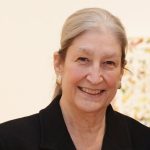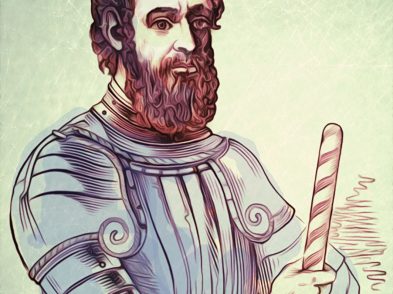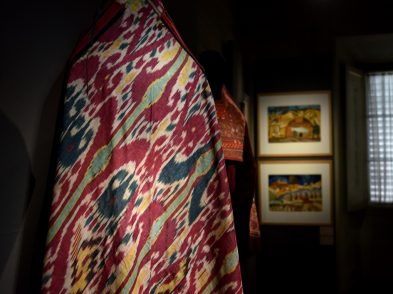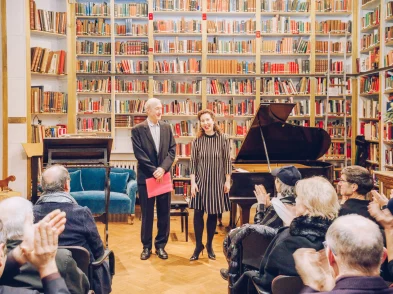Many religious orders had monumental representations of the Last Supper in the refectories (or eating rooms) of their monasteries and convents. This choice of subject matter was to remind the religious of Christ’s sacrificial self-perpetuation in the form of bread and wine. All monasteries were taken over by the Kingdom of Italy in the early 1900s, so several Last Suppers were only discovered after that time, due to the previously closed orders.
Last Supper frescoes abound in Florence, but where are‘the best’? Here are five I consider the most noteworthy.
Taddeo Gaddi (1300–1366)
In the refectory of the Museo dell’Opera di Santa Croce, one can find Taddeo Gaddi’s enormous fresco of the Last Supper, justbelow his Tree of the Cross, which has a Giotto-esque quality. Giotto was Gaddi’smaster and the two painters worked together for many years. The oldest survivingLast Supper in Florence, Gaddi’s fresco was badly damaged during the 1966 floodand restored by detaching the work from the wall all in one piece—a truly amazing feat.
One should notoverlook another important work in the refectory: Cimabue’s large crucifix,originally hung above the altar in the church of Santa Croce. It too wasravaged by the flood and masterfully restored, though much of its originalpaint could not be saved.
Museo dell’Opera di Santa Croce
Hours: 9:30am–5:30pm
Sunday: 1:30pm–5:30pm
There is a fee to enter the Chiesa Santa Croce, but the ticket includes a visit to the museo.
Andrea del Castagno (1420–57)
The youngest of Masaccio’s followers, Andrea del Castagno applied Brunelleschi’s rules of perspective by creating an illusion ofspace in his Last Supper (1447). Located in the refectory of the formerconvent of Sant’Apollonia, his intense scene conveys a dignified silentdialogue through the hands of his figures. Often considered his masterpiece,this beautiful work was not found until the early 1800s; until then, theconvent had been a closed order.
I once read thefollowing critique of this fresco: ‘His 12 figures do not correspond to the sixpanels behind them. We read the room as a square, because three of its sideshave six panels. But the friezes to left and right equal 17 quilloches (17 isthe unluckiest number in Italy); the back frieze equals 33 and a halfquilloches (Christ’s age at the time of the event). Ceiling panels number 16 indepth and 14 across (the vanishing point for the ceiling is in the middle ofthe tablecloth). The floor level is just below eye level creating a flickeringpattern, and the blocks cannot be counted at a close distance—an amazingexample of three dimensional reality, although his perspective is inaccurate!It was painted in less than 32 days (there are 32 sections of the painting).His work seems to foreshadow that of Caravaggio in late 16th, early 17th,centuries’.
Refectory ex-convent of Sant’Apollonia
Via XXVII Aprile, 1
Open 8:30pm–1:30pm, but call before visiting as hoursand days vary: 055.23 88 607
Il Perugino (Pietro di Cristoforo Vannucci, 1450–1523)
Although it is not known who taught Perugino (he mayhave worked with Verrocchio), we do know that he was master to Raphael.Religious studies held only slight meaning for this painter from Perugia; thushe often reduced his figures into repeated, similar patterns. Nonetheless, hewas a master of spatial composition. His Last Supper, located in therefectory of the Cenacolo di Fuligno, is one of the most important examples ofUmbrian culture during the Renaissance period. Because the Tertiary Franciscans Foligno was a closed order, this fresco was not discovered until the 1800s.There are varying opinions as to who actually executed the work; some say thatPerugino designed the piece, but it’s possible that his bottega may havepainted it.
Ex-convent of the TertiaryFranciscans Foligno
Via Faenza 42
Open 9am–2pm Monday, Tuesday and Saturday; or by appointment
call 055.02 86 982
Domenico del Ghirlandaio (Domenico Bigordi, 1449–94)
Trained as a metalworker, Domenico Bigordi earnedhimself the name ‘Ghirlandaio’, or garland-maker. His father created goldengarlands for wealthy Florentine women. Between 1476–1480, Ghirlandaio paintedfour Last Suppers in Florence. His best, finished in 1480, is the cenacolo of Ognissanti. He had perhaps are most consistent sense of color than any Florentine painter of his time and was familiar with both architecture andcomposed figures, and thus, was able to masterfully blend architectural spacesand people with a ‘complex unity’—a technique not yet common in his time. InOgnissanti, visitors can also appreciate a sinopia, a sketch drawn in red earthpigment on the rough wall, of this work.
In the smallrefectory of the Museo di San Marco, one can find another Last Supper by Ghirlandaio.Quite similar to the one in Ognissanti, it is worth a visit for comparison.Famous for giving character to his figures, Ghirlandaio’s view of the everydaylife and common surroundings made him very popular with the Florentines.
Refectory of the church of Ognissanti
Piazza Ognissanti, 42
The refectory, to the left of the church, is open Monday, Tuesday and Saturday 9am–12pm.
Andrea del Sarto (1486–1530)
Andrea del Sarto’s lovely Last Supper is locatedoutside of the centre of Florence, in the refectory of the Cenacolo di SanSalvi. Well worth the visit, this wonderful fresco is a true masterpiece. Thecolors, the movement, and his attention to small details are breath-taking.After Leonardo da Vinci’s Last Supper, this rendition of the Last Supper is the most widely recognized.
Museo di San Salvi
via San Salvi, 16
(a 7–10 minute taxi ride from Piazza Santa Croce)
Open 8:30am–1:30pm; Tuesday–Sunday; but call before going: 055.23 88 603
Several readers have asked me to recommend a guidebookto the city. A book I often rely on is Alta Macadam’s comprehensive Blue Guide Florence, which I consider the authority in the field. (J.F.)








